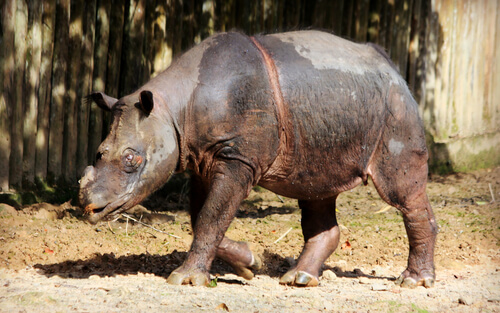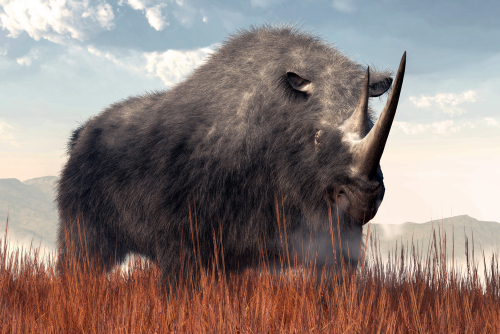
| Kingdom | Animalia |
| Phylum | Chordata |
| Class | Mammalia |
| Order | Perissodactyla |
| Family | Rhinocerotidae |
| Genera | Ceratotherium, Dicerorhinus, Diceros, Rhinoceros, Coelodonta (extinct), Stephanorhinus (extinct), Elasmotherium (extinct) |
| Species | Various |
| Niche | Consumer |
| Length | 11-15 ft (3.5-4.6 c) |
| Weight | 4000-5000 lbs (1600-2400 kg) |
| Lifespan | 40-50 years |
| Social Structure | Grouping |
| Conservation Status | Critically Endangered |
| Preferred Habitat | Grasslands, swamps, rain forests |
| Average Number of Offspring | 1 |
| Main Food Items | Trees, shrubs, bushes, fruit, grasses |
| Predators | Humans, wild cats, crocodiles, African wild dogs, hyenas |
The Basics
Rhinoceros, commonly abbreviated as “rhino”, is a large, armored ungulate native to Africa and Southern Asia. They boast distinct large horns on their noses and a thick skin formed of layers of collagen. They are among the largest terrestrial animals in the world. For example, the male White rhino (Ceratotherium simum) can weigh up to five tons.
Rhinos are herbivorous, with their diets varying depending on the species and its habitat. The White rhino, which spends most of its time in African grasslands, subsisting mostly on grasses. It lacks teeth and simply plucks its food using its large, strong lips. In contrast, the Javan rhino, which spends much of its time in the forests and swamps of southeast Asia, will consume various small trees, shrubs, and fruits found in this habitat. For this more fibrous food, these species have retained their front teeth.
Rhinoceros generally spend their time alone, forming small groups at times. These groups generally consist of females and their young, born one at a time after up to an 18-month pregnancy. Adults have few natural predators, although large animals such as crocodiles and lions pose a threat to their young.

In reality, humans are the largest threat to rhinoceros. Besides widespread habitat destruction, humans have hunted and illegally poached many species to extinction or to the very brink of it. Rhinoceros horns are traded on the black market for use in some traditional medicines. In fact, rhino horns are as valuable as gold in these marketplaces. However, these horns have little therapeutic effect. In fact, they are made of Keratin, the same protein material that your hair and fingernails are made of.
What’s in a Name?
Extant rhinoceros genera can be divided into three categories: the two African species Black rhinos (Diceros spp.) and White rhinos (Ceratotherium spp.), Indian and Javan rhinoceros (Rhinoceros spp.), and the Sumatran rhino (Dicerorhinus sumatrensis spp.). All of these species are parts of ancient lineages and are uniquely fascinating.
African White Rhinoceros
White rhinos and Black rhinos both inhabit Africa, but the species diverged some 14 million years ago during the middle Miocene epoch. The primary difference between the two is the shape of their mouths: Black rhinos have long lips they use to pluck foliage whereas White rhinos have broad, flat lips for grazing mostly on grasses.
White rhinos, of which there are two subspecies (C. simum simum, C. simum cottoni), are massive. They have huge bodies and heads, with short necks and broad chests. Females weigh 4000 lbs (1600 kg) and males nearly 5000 lbs (2400 kg) and are up to 15 ft (4.6 m) long and 6.6 ft (2 m) tall.
Their front horn is larger than their other horn and can reach up to 59 inches (150 cm) long. The White rhino isn’t actually white, but ranges in color from yellowish-brown to grey and has some body hair, mostly concentrated in its ear fringes and tail bristles. The origin of its name is unclear but may be an adaptation of Afrikaans or Dutch words perhaps referring to its ‘wide’ lips.
African Black Rhinoceros
The Black rhinoceros (D. bicornis) was named so simply to distinguish it from the poorly named White rhino, but is not actually black nor is color the distinguishing feature between the two species. Instead, it is the shape of their mouths that most easily allows one to tell them apart. The Black rhino is also smaller, with adult males reaching about 3500 lbs (1600 kg), 13 ft (3.9 m) in length, and 5.8 ft (1.75 m) tall. Like the White rhino, they have two horns, with the front one being the largest. However, it does not grow quite as large as that of the White rhino.

Due to hunting and illegal poaching, all rhino populations have drastically reduced. White rhino populations are actually increasing, but they are still listed as “Near Threatened” by the IUCN. The number of wild Black rhinos was greatly reduced from around 70,000 individuals in 1970 to just 2,410 in 1995. As a result of conservation efforts and public awareness of the crisis, these numbers have been slowly increasing. However, populations are still reduced by more than 90% of 1970 levels. They are listed as “Critically Endangered” by the IUCN.
Indian and Javan Rhinoceros
There are two living members of the genus Rhinoceros, the Indian rhino (R. unicornis), and the Javan rhino (R. sondaicus). These two species diverged from each other about 10 million years ago.
The Indian rhino is sometimes called the one-horned rhino, as it has a single long horn that can reach up to 35 in (60 cm). It is almost as large as the White rhino, with thick, brownish skin and a plated or armored appearance. It has very little body hair, and its upper legs and shoulders are covered in wart-like features.
They once inhabited areas ranging from Pakistan to Myanmar, but have since been reduced to just a few protected areas in India and Nepal. They spend their time in the tall grasslands and forests in the foothills of the Himalayan mountains. Indian rhinos are listed as “Vulnerable” on the IUCN Red List.

Though once widespread though Asia, the Javan rhino is one of the most endangered mammals in the world, with only about 60 remaining in the wild, on the island of Java, Indonesia. It is smaller than the Indian rhino but has a similar plated appearance and just one horn. They prefer dense rain forest habitats, as well as tall grass and floodplains.
Javan rhinos were once found in Nepal, India, Burma, and Malaysia but hunted nearly to extinction by the 1930s. The last known Javan rhino in Vietnam was killed for its horn in 2011 by poachers. Javan rhinos are listed as “Critically Endangered”.
Sumatran Rhinoceros
The most primitive group of rhinos is Dicerorhinini, of which the Sumatran rhino (Dicerorhinus sumatrensis) is the only extant species. This group emerged in the early Miocene, about 20 million years ago, and is the smallest living species of rhinos, reaching up to 1500 lb (700 kg).

A relative of the extinct Woolly rhino (Coelodonta spp.), Sumatran rhinos are the hairiest of all extant rhino species. Like its African cousins, it has two horns with the front one being the largest.
The Sumatran rhino was also once widespread throughout Southeast Asia but now lives only in high altitudes in Sumatra and Borneo. Due to habitat loss and poaching, their numbers have declined greatly, making it perhaps the most threatened of all rhino species. With only 275 individuals remaining it is also listed as “Critically Endangered” by the IUCN.
Extinct Species
The only remaining family of rhinos is Rhinocerotidae. This family first appeared in Eurasia in the Late Eocene. There were up to 26 genera at its peak, and many species were small and ubiquitous. Most disappeared during a wave of extinctions during the middle Oligocene. Some species, such as the Woolly rhino (Elasmotherium sibiricum), remained until the last Ice Age.
The species above share a common, hornless ancestor known as Hyrachyus eximus, whose fossil record dates back to the early Eocene in North America. Later in the Eocene, three families – Hyracodonitidae, Amynodontidae, and Rhinocerotidae – emerged. All living species are members of Rhinocerotidae, while the other two are completely extinct. Sometimes, these families are classified together as a Superfamily called Rhinocerotoidea.

Fun Facts about Rhinoceros!
As we’ve already seen, rhinos inhabit more than just the grassy plains of Africa. Some species enjoy swamps, forests and dense jungles instead. In exploring the ancient lineage of rhinos, we can see how they used to occupy even more diverse niches.
The Running Rhinos
The extinct family Hyracondontidae is also called “running rhinos” due to apparent adaptations that allowed them to move much more quickly than the rhinos we know. In general, they would have looked more like horses than rhinos, and some were as small as dogs. Others, such as Paracetherium spp., are among the largest terrestrial mammals that have ever existed. It was hornless and stood almost 21 ft (7 m) tall and weighed up to 15 tons (13 900 kg)! This family existed throughout Eurasia from the mid-Eocene until the early Miocene, before becoming extinct some 20 million years ago.
Aquatic Rhinos
Although you may not think of rhinos as aquatic, another family that has gone extinct is Amynodontidae. This family is often referred to as “aquatic rhinos”, as they filled a niche similar to the modern-day hippopotamus, inhabiting swamps, rivers, and lakes.
Wanted, Alive not Dead
Around the world, conservation efforts aim to make use of the growing industry of eco-tourism to preserve species and ecosystems. By integrating economic development with environmental conservation, it might be possible to allow for these species to recover free from the pressure of humans, many of whom are motivated by monetary gains.
Rhinos are a strong candidate for such efforts, as they are charismatic megafauna – a large animal that people generally seem to care about. Because ultimately, we have to be persuaded that these increasingly rare species are worth more to us alive than dead if they are to stand any chance of survival.
